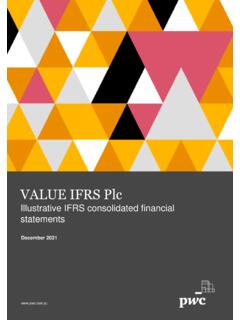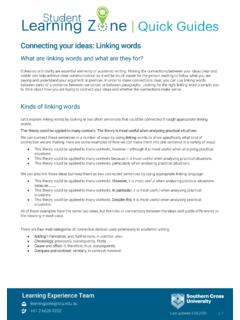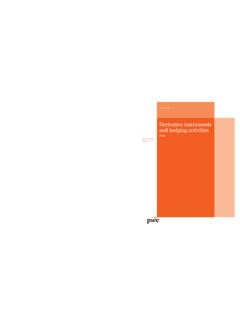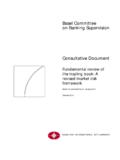Transcription of Financing transactions,PwC's Financing transactions - 2021
1 TransactionsPartially updated February 2021 About the Financing transactions guide PwC is pleased to offer our updated Financing transactions guide. This guide is intended to help our clients and other interested parties implement and apply the applicable accounting and reporting standards. The accounting guidance for the issuance, modification, conversion, and repurchase of debt and equity securities has developed over many years into a complex set of rules. This guide provides a summary of the guidance relevant to the accounting for debt and equity instruments and serves as a roadmap to the applicable accounting literature. Portions of this guide assume that ASU 2020-06, Debt-Debt with Conversion and Other Options (Subtopic 470-20) and Derivatives and hedging -Contracts in an Entity s Own Equity (Subtopic 815-40), have been adopted.
2 This guidance has significantly changed the accounting for convertible debt and has simplified the accounting for contracts in an entity s own equity. Each chapter discusses the relevant accounting literature and includes specific questions and examples to illustrate its application. See PwC s Financial statement presentation guide for information on financial statement presentation and disclosure of the instruments and transactions discussed in this guide. See PwC s Income taxes guide for income tax accounting considerations related to debt and equity-linked financial instruments. References to US GAAP Definitions, full paragraphs, and excerpts from the FASB s Accounting Standards Codification are clearly labelled.
3 In some instances, guidance was cited with minor editorial modification to flow in the context of the PwC Guide. The remaining text is PwC s original content. References to other PwC guidance This guide provides general and specific references to chapters in other PwC guides to assist users in finding other relevant information. References to other guides are indicated by the applicable guide abbreviation followed by the specific section number. The other PwC guides referred to in this guide, including their abbreviations, are: Business combinations and noncontrolling interests (BCG) Consolidation and equity method of accounting guide (CG) Derivative instruments and hedging activities (DH) Fair value measurements, global edition (FV) Not-for-profit entities (NP) Carve-out financial statements (CO) Financial statement presentation (FSP)About this guide iv Income taxes (TX) Stock-based compensation (SC) Transfers and servicing of financial assets (TS)Summary of significant changes Following is a summary of the recent noteworthy revisions to the guide.
4 Additional updates may be made to future versions to keep pace with significant developments. Revisions made in February 2021 Chapter 10, ASU 2020-06 effective date and transition This chapter was added to discuss the effective date and transition requirements, including thetransition disclosures, related to the adoption of ASU made in October 2020 Chapter 3, Debt modification and extinguishment FG was added to discuss modifications or exchanges of delayed draw term 4, Common stock and dividends FG was added to discuss common stock issuance costs. FG was added to discuss modifications or exchanges of common stock. FG was updated to provide additional commentary on dividends in 5, Equity-linked instruments model FG was added to discuss the analysis of a freestanding equity-linked instrument after adoptionof ASU 2020-06, Debt Debt with Conversion and Other Options (Subtopic 470-20) andDerivatives and hedging Contracts in Entity s Own Equity (Subtopic 815-40), includingexamples.
5 FG was added to discuss the additional disclosures required for contracts in an entity s ownequity after adoption of ASU 2020-06, Debt Debt with Conversion and Other Options (Subtopic470-20) and Derivatives and hedging Contracts in Entity s Own Equity (Subtopic 815-40).Chapter 6, Convertible debt after adoption of ASU 2020-06 FG 6 was updated to discuss the accounting for convertible debt after the adoption of ASU 2020-06, Debt with Conversion and Other Options (Subtopic 470-20) and Derivatives and hedging -Contracts in an Entity s Own Equity (Subtopic 815-40). The discussion includes accounting forissuances, conversions, and extinguishments. Additional disclosure requirements are this guide v The accounting for convertible debt before the adoption of ASU 2020-06, Debt with Conversionand Other Options (Subtopic 470-20) and Derivatives and hedging -Contracts in an Entity sOwn Equity (Subtopic 815-40) was moved to FG 7, Preferred stock FG , including Figure FG 7-3, was added to discuss classification of preferred stock afteradoption of ASU 2020-06, Debt Debt with Conversion and Other Options (Subtopic 470-20)and Derivatives and hedging Contracts in Entity s Own Equity (Subtopic 815-40).
6 FG was added to discuss the accounting for a down round feature in convertible preferredstock after the adoption of ASU 2020-06, Debt Debt with Conversion and Other Options(Subtopic 470-20) and Derivatives and hedging Contracts in Entity s Own Equity (Subtopic815-40). FG was amended to clarify the treatment of commitments to issue shares of tranchedpreferred stock as a freestanding instrument after the adoption of ASU 2020-06, Debt Debt withConversion and Other Options (Subtopic 470-20) and Derivatives and hedging Contracts inEntity s Own Equity (Subtopic 815-40). FG was added to clarify the accounting for paid-in -kind 9, Share repurchase and treasury stock FG was amended to discuss the treatment of net cash or net share settled forwardrepurchase contracts in the computation of diluted earnings per share after the adoption of ASU2020-06, Debt Debt with Conversion and Other Options (Subtopic 470-20) and Derivatives andHedging Contracts in Entity s Own Equity (Subtopic 815-40).
7 FG was added to discuss the accounting for prepaid forward repurchase contracts. FG was added to discuss the treatment of accelerated share repurchase programs in dilutedearnings per share after the adoption of ASU 2020-06, Debt Debt with Conversion and OtherOptions (Subtopic 470-20) and Derivatives and hedging Contracts in Entity s Own Equity(Subtopic 815-40).Copyrights This publication has been prepared for general informational purposes, and does not constitute professional advice on facts and circumstances specific to any person or entity. You should not act upon the information contained in this publication without obtaining specific professional advice. No representation or warranty (express or implied) is given as to the accuracy or completeness of the information contained in this publication.
8 The information contained in this publication was not intended or written to be used, and cannot be used, for purposes of avoiding penalties or sanctions imposed by any government or other regulatory body. PricewaterhouseCoopers LLP, its members, employees, and agents shall not be responsible for any loss sustained by any person or entity that relies on the information contained in this publication. Certain aspects of this publication may be superseded as new guidance or interpretations emerge. Financial statement preparers and other users of this publication are therefore cautioned to stay abreast of and carefully evaluate subsequent authoritative and interpretative guidance. About this guide vi The FASB Accounting Standards Codification material is copyrighted by the Financial Accounting Foundation, 401 Merritt 7, Norwalk, CT 06856, and is reproduced with permission.
9 PwC1-1 Chapter 1: Debt instruments Debt instruments Overview of debt instruments This chapter discusses the accounting considerations for various types of debt instruments including the following topics. Term debt Lines of credit and revolving-debt arrangements Debt accounted for at fair value based on the guidance in ASC 825, Financial Instruments Amortization of deferred debt issuance costs, debt discount and premium Put options, call options, and other embedded features in debt instrumentsSee FG 3 for information on the accounting for debt modifications and extinguishments, and FG 6 (post adoption of ASU 2020-06) or FG 6A (pre adoption of ASU 2020-06) for information on the accounting for convertible debt instruments.
10 See FSP 12 for information on the financial statement presentation and disclosure of debt instruments, including balance sheet classification. New guidance In August 2020, the FASB issued ASU 2020-06, Debt Debt with Conversion and Other Options (Subtopic 470-20) and Derivatives and hedging Contracts in Entity s Own Equity (Subtopic 815-40). The ASU simplifies the accounting for certain financial instruments with characteristics of liabilities and equity. The FASB reduced the number of accounting models for convertible debt and convertible preferred stock instruments and made certain disclosure amendments to improve the information provided to users. In addition, the FASB amended the derivative guidance for the own stock scope exception (see FG 5) and certain aspects of the EPS guidance.








